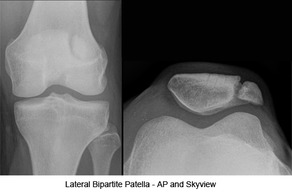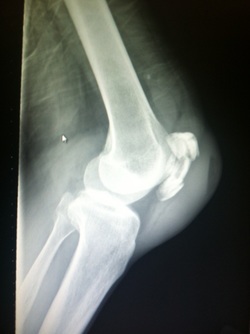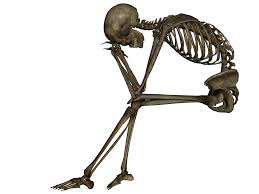|
HPI: young male s/p ATV accident Exam: Inspection: edema and deformity. No open wounds. Palpation: TTP, palpable deformity. 2+ DP/PT pulses. SILT lower extremity. ROM: unable to perform straight leg raise. limited ROM secondary to pain. Limited assessment of anterior/posterior drawer, varus/valgus testing Imaging: # Best seen on lateral xray. #In pediatric patients, MRI if xrays do not show fracture and child unable to perform straight leg raise  orthobullets.com orthobullets.com Bipartate patella: #often mistaken for fracture-use history and clinical exam #8-10 % of population, 50 % bilateral, usually superolateral Fracture Patterns:
Management: # Nonoperative: -Extensor mechanism intact (straight leg test) -nondisplaced/minimally displaced -vertical fractures -Knee immobilized in extension (cylinder cast/brace) #Operative -extensor mechanism failure -open fractures -articular displacement > 2 mm -displacement > 3 mm -patella sleeve fractures in children (fracture between cartilage sleeve and patella) -severely communited fractures Discussion: -Patella fractures 1 % of skeletal injuries -Mechanism: direct impact of indirect eccentric contraction -Complications: weakness and anterior knee pain, loss of reduction, nonunion, osteonecrosis, infection, stiffness Key Points: #History of mechanism and exam is important-especially palpation, straight leg testing #Best seen on lateral xray, consider MRI in pediatric patients given history and exam findings #Bipartate patella-seen in 8-10 % of population, usually superolateral #Orthopedic consultation-open vs closed, fracture pattern, straight leg testing, displacement #Consider patella sleeve fractures in pediatric patients #Management-minimally displaced, vertical, closed, extensor mechanism intact-immobilize in brace or cast and follow up as outpatient; Open, extensor mechanism not intact, communited, displaced-surgical
0 Comments
Your comment will be posted after it is approved.
Leave a Reply. |
Orthopedics BlogAuthorCMC ER Residents Archives
June 2018
Categories
All
Disclaimer: All images and x-rays included on this blog are the sole property of CMC EM Residency and cannot be used or reproduced without written permission. Patient identifiers have been redacted/changed or patient consent has been obtained. Information contained in this blog is the opinion of the author and application of material contained in this blog is at the discretion of the practitioner to verify for accuracy.
|


 RSS Feed
RSS Feed
